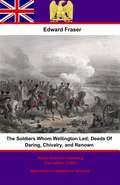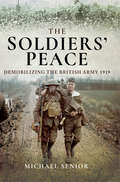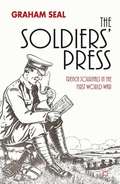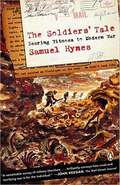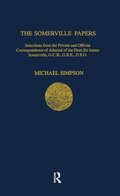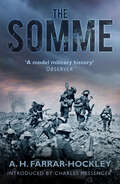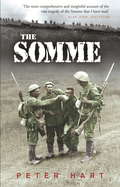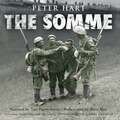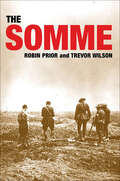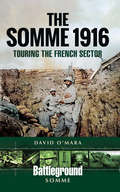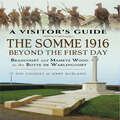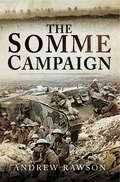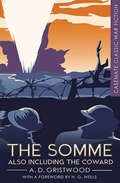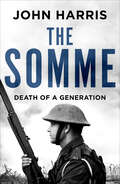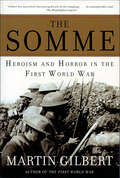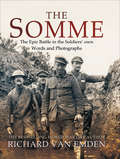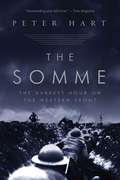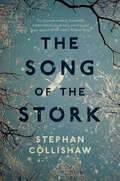- Table View
- List View
The Soldier's Valentine: A Clean Romance (Safe in Sarasota Falls #3)
by Pamela TracyAn old lifeVersus a new love…Past haunts are troubling former army man Gary Guzman enough that he turns to top officer Leann Bailey. Gary’s transition to civilian life is eased by his growing feelings for the single mother—Sarasota Falls’s first female cop. But when their investigation of his father’s disappearance unearths decades-old secrets, Gary will have to fight even harder for a future with Leann.
The Soldier: Rise of the Jain, Book One (Rise Of The Jain Ser. #1)
by Neal AsherIn a far corner of space, on the very borders between humanity&’s Polity worlds and the kingdom of the vicious crab-like prador, is an immediate threat to all sentient life: an accretion disc, a solar system designed by the long-dead Jain race and swarming with living technology powerful enough to destroy entire civilizations. Neither the Polity or the prador want the other in full control of the disc, so they&’ve placed an impartial third party in charge of the weapons platform guarding the technology from escaping into the galaxy: Orlandine, a part-human, part-AI haiman. She&’s assisted by Dragon, a mysterious, spaceship-sized alien entity who has long been suspicious of Jain technology and who suspects the disc is a trap lying-in-wait. Meanwhile, the android Angel is planning an attack on the Polity, and is searching for a terrible weapon to carry out his plans?a Jain super-soldier. But what exactly the super-soldier is, and what it could be used for if it fell into the wrong hands, will bring Angel and Orlandine&’s missions to a head in a way that could forever change the balance of power in the Polity universe. In The Soldier, British science fiction writer Neal Asher kicks off another Polity-based trilogy in signature fashion, concocting a mind-melting plot filled with far-future technology, lethal weaponry, and bizarre alien creations.
The Soldiers Whom Wellington Led; Deeds Of Daring, Chivalry, And Renown: Deeds Of Daring, Chivalry, And Renown (classic Reprint)
by Edward FraserThis ebook is purpose built and is proof-read and re-type set from the original to provide an outstanding experience of reflowing text for an ebook reader. Edward Fraser contributed a number of works on the Napoleonic period ranging from the Eagle-bearers of Napoleon to the sailors of the fleets of Nelson, Gravina and Villeneuve at Trafalgar, this volume focuses on the exploits of the soldiers who fought under Wellington in the Peninsular War between 1808 and 1814. Artfully interwoven into a short history of the war itself, Fraser focuses on the many daring and brave exploits of the British soldiers, and their Portuguese and Spanish allies during a conflict that was described by Napoleon as the "Spanish Ulcer". Ranging from the passage of the Douro in 1809 to the battle of Vittoria in 1814 the epic deeds are recounted in detail using the eye-witness accounts that survived; Talavera, Salamanca, Garcia Hernadez and the sieges of Badajoz and Cuidad Rodrigo are vivid colour. A pacy, account of hard-fighting against the veteran and gallant armies of Napoleon. Text taken, whole and complete, from the 1913 edition, published by Methuen and Co Ltd., London. Original -382 pages Illustrations - 12 - all included Maps - 5 - all included Author - Edward Fraser - (????-????) Linked TOC.
The Soldiers' Peace: Demobilizing the British Army, 1919
by Michael SeniorArmistice in 1918 presented the British government with an enormous challenge how could the British army that had been built up on an unprecedented scale during the war be cut back to a peacetime size and how could millions of soldiers be returned to civilian life?In November 1918, the last month of the war, the British army numbered 3.75 million. One year later that number was reduced to 890,000. This was a remarkable feat of demobilization but, as Michael Senior shows, it was by no means a trouble-free process. He describes in vivid detail how demobilization took place, the acute difficulties that arose, and how they were dealt with.The obstacles that had to be overcome were legion, and urgent, for the task had to be completed rapidly to prevent social unrest. At the same time prisoners of war had to be repatriated, the wounded and maimed had to be cared for and permanent cemeteries had to be laid out for the battlefield dead. In addition, war materiel had to be disposed and the army had to be reorganized into a force suitable for the challenges of 1919.The task was immense, as were the risks, and Michael Senior's study makes fascinating reading.
The Soldiers' Press
by Graham SealThrough the first comprehensive investigation and analysis of the English language trench periodicals of the First World War, The Soldiers' Press presents a cultural interpretation of the means and methods through which consent was negotiated between the trenches and the home front.
The Soldiers' Tale
by Samuel HynesThe Soldier's Tale is the story of modern wars as told by the men who did the actual fighting. Hynes examines the journals, memoirs, and letters of men who fought in the two World Wars and in Vietnam, and also the wars fought against the weak and helpless in concentration camps, prisoner-of-war camps, and bombed cities. Interweaving his own reflections on war with brilliantly chosen passages from soldiers' accounts, he offers vivid answers to the question we all ask of men who have fought: What was it like? In these powerful pages the experiences of modern war, which seem unimaginable to those who weren't there, become comprehensible and real. The wide range of writers examined includes both famous literary memoirists like Robert Graves, Tim O'Brien, and Elie Wiesel, and unknown soldiers who wrote only their war stories. Using these testimonies, Hynes considers each war in terms of its special circumstances and its effects on men who fought. His understanding of the psychology of warfare--and of each war's role in history--gives this study its intellectual authority; the voices of the men who were there, and wrote about what they saw and felt, give it its powerful dramatic impact.
The Solitary Spy: A Political Prisoner in Cold War Berlin
by Douglas BoydOf the 2.3 million National Servicemen conscripted during the Cold War, 4,200 attended the secret Joint Services School for Linguists, tasked with supplying much-needed Russian speakers to the three services. The majority were in RAF uniform, as the Warsaw Pact saw air forces become the greatest danger to the West. After training, they were sent to the front lines in Germany and elsewhere to snoop on Russian aircraft in real time. Posted to RAF Gatow in Berlin, ideally placed for signals interception, Douglas Boyd came to know Hitler’s devastated former capital, divided as it was into Soviet, French, US and British sectors. Pulling no punches, he describes the SIGINT work, his subsequent arrest by armed Soviet soldiers one night on the border, and how he was locked up without trial in solitary confinement in a Stasi prison. The Solitary Spy is a unique account of the terrifying experience of incarceration and interrogation in an East German political prison, from which Boyd eventually escaped one step ahead of the KGB.
The Somerville Papers: Selections from the Private and Official Correspondence of Admiral of the Fleet Sir James Somerville, GCB, GBE, DSO
by MICHAEL SIMPSON; JOHN SOMERVILLESir James Somerville (1882-1949) was one of the great influences on the 20th-century navy, both as a commander of fleets and a pioneer of radio and radar. The Admiral's extensive correspondence, diaries and reports are deposited in the Churchill Archives Centre at Cambridge. These edited selections reveal much of the background about major naval operations in the Second World War. The loneliness of high command is clearly revealed in these highly personal documents, almost 500 of which are reproduced in the book. In particular they show Somerville's frequent disagreements with Churchill - a feature common to all senior British commanders during the war.
The Somme
by Charles Messenger A.H. Farrar-HockleyOriginally published in 1964, this is a critically acclaimed classic history of the military engagements of the Somme that raged from July to November 1916. It tells of bloody battles interspersed with trench actions of dreadful intensity. In addition to the key confrontations, Farrar-Hockley provides a detailed background to the Somme planning and why it failed with dreadful casualties. In its entirety, the conflict along the Somme scarred the minds of a whole generation, becoming recorded by historians as the graveyard of the 'flower of British manhood'. With a new introduction by Charles Messenger, and a touching foreword by the author's son, Dair Farrar-Hockley, this new edition of The Somme is a testament to those who gave their lives on this famous battlefield.
The Somme
by Anthony RichardsBetween 1 July and 18 November 1916 Britain's new volunteer army took the leading role in a battle on the Western Front for the first time. The Somme offensive was intended to achieve a decisive victory for the British and French Allies over the Germans, yet the Allies failed to achieve all of their objectives and the war was to continue for another two years. Over a million men from both sides became casualties in the long and bitter struggle on the Somme in 1916.This audiobook tells this story through the unique collections of IWM. Using artefacts, medals, documents, interviews, film, art, and photographs, it reconstructs not only the history of the famous battle, but provides an intimate insight into the experiences of those who were there.(P)2021 Headline Publishing Group Limited
The Somme
by Peter Hart Nigel SteelA major new history of the most infamous battle of the First World War, as described by the men who fought it.On 1 July 1916, Douglas Haig's army launched the 'Big Push' that was supposed finally to bring an end to the stalemate on the Western Front. What happened next was a human catastrophe: scrambling over the top into the face of the German machine guns and artillery fire, almost 20,000 British and Commonwealth soldiers were killed that day alone, and twice as many wounded - the greatest loss in a single day ever sustained by the British Army. The battle did not stop there, however. It dragged on for another 4 months, leaving the battlefield strewn with literally hundreds of thousands of bodies. The Somme has remained a byword for the futility of war ever since. In this major new history, Peter Hart describes how the battle looked from the point of view of those who fought it. Using never-before-seen eyewitness testimonies, he shows us this epic conflict from all angles. We see what it was like to crawl across No Man's Land in the face of the German guns, what it was like for those who stayed behind in the trenches - the padres, the artillerymen, the doctors. We also see what the battle looked like from the air, as the RFC battled to keep control of the skies above the battlefield. All this is put in the context of the background to the battle, and Haig's overall strategy for the Western Front, making this the most comprehensive history of the battle since Lyn MacDonald's bestselling work over 20 years ago.
The Somme
by Peter Hart Nigel SteelOn 1 July 1916, Dauglas Haig's army launched the 'Big Push' that was supposed finally to bring the end to the stalemate on the Western Front. What happened next was a human catastrophe: scrambling over the top into the face of the German machine guns and artillery fire, almost 20,000 British and Commonwealth soldiers were killed that day alone, and twice as many wounded - the greatest loss in a single day ever sustained by the British Army. The battle did not stop there, however. It dragged on for another 4 months, leaving the battlefield strewn with literally hundreds of thousands of bodies.The Somme has remained a byword for the futility of war ever since. In this major new history, Peter Hart describes how the battle looked from the point of view of those who fought it. Using never-before-seen eyewitness testimonies, he shows us this epic conflict from all angles. We see what it was like for those who stayed behind in the trenches - the padres, the artillerymen, the doctors. We also see what the battle looked like from the air, as the RFC battled to keep control of the skies above the battlefield.Read by Tim Pigott-Smith(p) 2005 Orion Publishing Group
The Somme
by Robin Prior Trevor WilsonIn the long history of the British Army, the Battle of the Somme was its bloodiest encounter. Between July 1 and mid-November 1916, 432,000 of its soldiers became casualties--about 3,600 for every day of battle. German casualties were far fewer despite British superiority in the air and in lethal artillery.What went wrong for the British, and who was responsible? Robin Prior and Trevor Wilson have examined the entire public archive on the Battle of the Somme to reconstruct the day-by-day course of the war. The result is the most precise and authentic account of the campaign on record and a book that challenges almost every received view of the battle. The colossal rate of infantry casualties in fact resulted from inadequate fire support; responsibility for tactical mistakes actually belonged to the High Command and the civilian War Committee. Field-Marshall Haig, the records show, was repeatedly deficient in strategy, tactics, command, and organization. Hundreds of thousands of soldiers died for a cause that lacked both a coherent military plan and responsible political leadership. Prior and Wilson decisively change our understanding of the history of the Western Front.
The Somme 1916: & Other Experiences of the Salford Pals
by Michael StedmanSalford was late in recruiting for its Pals battalions, with many of its men already joining Territorial units and a new Pals battalion in Manchester. Yet within a year it had raised four Pals battalions and a reserve battalion. Raised mainly from Lancashire's most notorious slums, the men trained together in Wales, North East England, and on Salisbury Plain, they had great expectations of success. On the 1st of July 1916, the Somme offensive was launched and in the very epicenter of that cauldron the first three of Salford's battalions were thrown at the massive defenses of Thiepval - the men were decimated, Salford was shattered. Michael Stedman records the impact of the war from the start on Salford and follows the difficulties and triumphs. Whether the actions small or great the author writes graphically about them all. Unusual photographs and a variety of sources make this both a readable and a scholarly account.
The Somme 1916: Touring the French Sector (Battleground Somme)
by David O'MaraWith a few notable exceptions, the French efforts on the Somme have been largely missing or minimized in British accounts of the Battle of the Somme. And yet they held this sector of the Front from the outbreak of the war until well into 1915 and, indeed, in parts into 1916. It does not hurt to be reminded that the French army suffered some 200,000 casualties in the 1916 offensive.David OMaras book provides an outline narrative describing the arrival of the war on the Somme and some of the notable and quite fierce actions that took place that autumn and, indeed, into December of 1914. Extensive mine warfare was a feature of 1915 and beyond on the Somme; for example under Redan Ridge and before Dompierre and Fay. The French limited offensive at Serre in June 1915 is reasonably well known, but there was fighting elsewhere for example the Germans launched a short, sharp, limited attack at Frise in January 1916, part of the diversionary action before the Germans launched their ill-fated offensive at Verdun.The book covers the Somme front from Gommecourt, north of the Somme, to Chaulnes, at the southern end of the battle zone of 1916. The reader is taken around key points in various tours. For many British visitors the battlefields south of the Somme will be a revelation; there is much to see, both of cemeteries and memorials, but also substantial traces of the fighting remain on the ground, some of which is accessible to the public.It has always been something of a disgrace that there is so little available, even in French, to educate the public in an accessible written form about the substantial effort made by Frances army on the Somme; this book and subsequent, more detailed volumes to be published in the coming years will go some way to rectify this. British visitors should be fascinated by the story of these forgotten men of France and the largely unknown part of the Somme battlefield.
The Somme 1916—Beyond the First Day: Beaucourt and Mametz Wood to the Butte de Warlencourt (A Visitor's Guide)
by Jon Cooksey Jerry MurlandIn their second Visitor’s Guide to the 1916 Battle of the Somme Jon Cooksey and Jerry Murland focus on the series of secondary battles that were key stages in the five-month struggle that followed the start of the offensive on 1 July. They take the visitor – and the reader – across the entire battlefield, covering in graphic detail sites where actions took place that are almost as famous as the Somme itself in the history of the First World War, including Mametz Wood, High Wood, Deville Wood, Guillemont, Ginchy, Pozieres and Flers. They also provide tours of the less-well-known but equally interesting sites which played important parts in the offensive as a whole. In a sequence of routes that can be walked, biked or driven they describe what happened in each place, identify the units involved, highlight the experience and exploits of individual soldiers, and point out the notable sights, monuments and cemeteries. This highly illustrated guidebook is essential reading for visitors who wish to enhance their understanding of the Battle of the Somme and the war on the Western Front. It is also the ideal companion volume to The First Day of the Somme: Gommecourt to Maricourt by the same authors.
The Somme Campaign
by Andrew RawsonThe five and a half month long Somme campaign in the summer and autumn of 1916 was a defining moment in the history of the British Army. From the disastrous opening day on 1 July to the final attacks in November, each large battle and minor action is given equal treatment inside these pages.The book concentrates on the British Army's repeated efforts to first break through the enemy lines,and then to wear down the German in a bloody war of attrition. By compiling information from the Official History and the printed histories we get a balanced view of the most talked about side of the campaign, the British side.You will find plenty of information on the reasoning behind each battle and the objectives. There is discussion on artillery bombardments, tactics, zero hours, the terrain and insights into the successes and failures of each attack. Over ninety new maps chart the day by day progress of Fourth and the Reserve Armyacross the rolling chalk downs of the Somme.Together the narrative and mapsprovide an insight into the British Army's learning curve during that fateful summer; a learning curve which set the scene for future battles on the Western Front. We can see the hard lessons learnt and the solutions used to solve a multitude of problems, from communication and all arms co-operation, to the inclusion of tanks and the growing role of the Royal Flying Corps.Where possible the men who made a difference are mentioned; the men who lead the assault companies and bombing teams, those who cut the wire and led the survivors into the German trenches, those who stopped the counterattacks and those awarded the Victoria Cross.Discover the real Somme campaign fought by the British Army and learn how its brave soldiers fought hard to achieve their objectives.
The Somme: Also Including The Coward (Casemate Classic War Fiction #3)
by A. D. GristwoodTwo World War I classics: The story of a British soldier enduring the battle in France and a novella starring a man who takes drastic steps to escape the Great War.The million British dead have left no books behind. What they felt as they died hour by hour in the mud, or were choked horribly with gas, or relinquished their reluctant lives on stretchers, no witness tells. But here is a book that almost tells it. . . . Mr. Gristwood has had the relentless simplicity to recall things as they were; he was as nearly dead as he could be without dying, and he has smelt the stench of his own corruption. This is the story of millions of men—of millions.&” —H. G. Wells In The Somme and its companion The Coward, first published in 1927, the heroics of war and noble self-sacrifice are completely absent, replaced by the gritty realism of life for the ordinary soldier in World War I and an unflinching portrayal of the horrors of war. Written under the guidance of master storyteller H. G. Wells, they are classics of the genre. Based on A. D. Gristwood&’s own wartime experiences, The Somme revolves around a futile attack during the 1916 Somme campaign. On the battlefront, Tom Everitt is wounded and must be moved back through a series of dressing stations to the General Hospital at Rouen. Few other accounts of the war give such an accurate picture of trench life, and The Spectator praised Gristwood&’s &“very effective writing,&” calling The Somme &“a book which anyone who was not in the War should read.&”The Coward concerns a man who shoots himself in the hand to escape the chaos during the March 1918 retreat—an offense punishable by death—and is haunted by fear of discovery and self-loathing. Together, these works offer a vivid, immersive view of the First World War and the suffering it inflicted on the men who fought it.
The Somme: Death of a Generation
by John HarrisThe bloodiest battle in the history of the British Army.In 1916 the Great War seemed caught in a stalemate. The British were determined to break it with a huge summer push. By the time the campaign wound down in November, it proved to be the most destructive ever encounter for the Army, seeing thousands of casualties for every day of the conflict. It wasn’t meant to have been like this: the British had a massive artillery superiority, and were primed to crush their enemy. In the end, despite fierce fighting, the Germans lost far fewer men.The Somme has come to be an emblem for the horrors of war, for the pounding of shells and the hunkering down in rain-sodden trenches. What happened? How did it go so wrong for the British? Here in sharp detail, the bestselling writer John Harris tells the story of one the key battles of world history, describing in gripping terms how a series of events soon spiralled wildly, and hopelessly, out of control.This is an unforgettable history of assault and bitter defence that takes the reader into the ferocious heart of a conflict whose scars remain today.
The Somme: Herosim and Horror in the First World War
by Martin GilbertFrom one of our most distinguished historians, an authoritative and vivid account of the devastating World War I battle that claimed more than 300,000 livesAt 7:30 am on July 1, 1916, the first Allied soldiers climbed out of their trenches along the Somme River in France and charged out into no-man's-land toward the barbed wire and machine guns at the German front lines. By the end of this first day of the Allied attack, the British army alone would lose 20,000 men; in the coming months, the fifteen-mile-long territory along the river would erupt into the epicenter of the Great War. The Somme would mark a turning point in both the war and military history, as soldiers saw the first appearance of tanks on the battlefield, the emergence of the air war as a devastating and decisive factor in battle, and more than one million casualties (among them a young Adolf Hitler, who took a fragment in the leg). In just 138 days, 310,000 men died.In this vivid, deeply researched account of one history's most destructive battles, historian Martin Gilbert tracks the Battle of the Somme through the experiences of footsoldiers (known to the British as the PBI, for Poor Bloody Infantry), generals, and everyone in between. Interwoven with photographs, journal entries, original maps, and documents from every stage and level of planning, The Somme is the most authoritative and affecting account of this bloody turning point in the Great War.
The Somme: The Darkest Hour On The Western Front
by Peter Hart Nigel SteelA major new history of the most infamous battle of the First World War, as described by the men who fought it. On 1 July 1916, Douglas Haig's army launched the 'Big Push' that was supposed finally to bring an end to the stalemate on the Western Front. What happened next was a human catastrophe: scrambling over the top into the face of the German machine guns and artillery fire, almost 20,000 British and Commonwealth soldiers were killed that day alone, and twice as many wounded - the greatest loss in a single day ever sustained by the British Army. The battle did not stop there, however. It dragged on for another 4 months, leaving the battlefield strewn with literally hundreds of thousands of bodies. The Somme has remained a byword for the futility of war ever since. In this major new history, Peter Hart describes how the battle looked from the point of view of those who fought it. Using never-before-seen eyewitness testimonies, he shows us this epic conflict from all angles. We see what it was like to crawl across No Man's Land in the face of the German guns, what it was like for those who stayed behind in the trenches - the padres, the artillerymen, the doctors. We also see what the battle looked like from the air, as the RFC battled to keep control of the skies above the battlefield. All this is put in the context of the background to the battle, and Haig's overall strategy for the Western Front, making this the most comprehensive history of the battle since Lyn MacDonald's bestselling work over 20 years ago.
The Somme: The Epic Battle in the Soldiers' own Words and Photographs
by Richard van EmdenThe epic and brutal WWI battle is vividly recounted through the words and photos of the soldiers who lived through it. One of the most famous battles of the Great War, the offensive on the Somme took place in 1916, from July and November. It was there that Kitcheners famous Pals Battalions were first sent into action en masse. It was a battlefield where many of the dreams and aspirations of a nation, hopeful of victory, were agonizingly dashed. Because of its legendary status, the Battle of the Somme has been the subject of many books. Yet this volume is the first of its kind, in which the soldiers&’ own stories and photographs are used to illustrate both the campaign's extraordinary comradeship and its carnage.
The Somme: The Royal Flying Corps And The Battle Of The Somme 1916
by Peter HartOne of the bloodiest battles in world history—a military tragedy that would come to define a generation.On July 1, 1916, the British Army launched the &“Big Push&” that was supposed to bring an end to the horrific stalemate on the Western Front between British, French, and German forces. What resulted was one of the greatest single human catastrophes in twentieth century warfare. Scrambling out of trenches in the face of German machine guns and artillery fire, the Allied Powers lost over twenty thousand soldiers that first day. This &“battle&” would drag on for another four bloody months, resulting in over one million causalities among the three powers. As the oral historian at the Imperial War Museum in London, Peter Hart has brought to light new material never before seen or heard. The Somme is an unparalleled evocation of World War I&’s iconic contest—the definitive account of one of the major tragedies of the twentieth century.
The Song of the Jade Lily: A Novel
by Kirsty Manning“Kirsty Manning weaves together little-known threads of World War II history, family secrets, the past and the present into a page-turning, beautiful novel."— Heather Morris, #1 New York Times bestselling author of The Tattooist of AuschwitzA gripping historical novel that tells the little-known story of Jewish refugees who fled to Shanghai during WWII.1939: Two young girls meet in Shanghai, also known as the “Paris of the East”. Beautiful local Li and Jewish refugee Romy form a fierce friendship, but the deepening shadows of World War II fall over the women as they slip between the city's glamorous French Concession district and the teeming streets of the Shanghai Ghetto. Yet soon the realities of war prove to be too much for these close friends as they are torn apart. 2016: Fleeing London with a broken heart, Alexandra returns to Australia to be with her grandparents, Romy and Wilhelm. Her grandfather is dying, and over the coming weeks Romy and Wilhelm begin to reveal the family mysteries they have kept secret for more than half a century. As fragments of her mother's history finally become clear, Alexandra struggles with what she learns while more is also revealed about her grandmother's own past in Shanghai.After Wilhelm dies, Alexandra flies to Shanghai, determined to trace her grandparents' past. Peeling back the layers of their hidden lives, she is forced to question what she knows about her family—and herself. The Song of the Jade Lily is a lush, provocative, and beautiful story of friendship, motherhood, the price of love, and the power of hardship and courage that can shape us all.
The Song of the Stork: A Story Of Love, Hope And Survival
by Stephan CollishawA Jewish girl finds refuge with a village outcast during WWII in this &“elegantly crafted, beautifully written novel about love, survival and hope&” (William Ryan). In a small Eastern European village, fifteen-year-old Yael is on the run from Nazi invaders. The so-called village idiot, Aleksei is a solitary mute who does not want for company. But as the brutal winter advances, he reluctantly takes Yael in. As she begins to win his trust, a delicate relationship develops between them. But beyond Aleksei&’s remote homestead, the war rages on, and Yael cannot hide forever. A Jewish partisan group is organizing in the woods to mount a counterattack. Torn between her love and her need to fight, Yael must find her voice as the voices around her are being extinguished.


